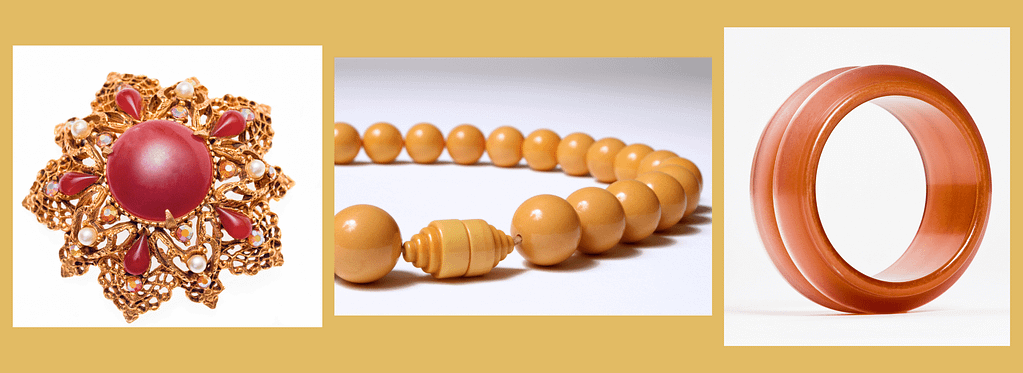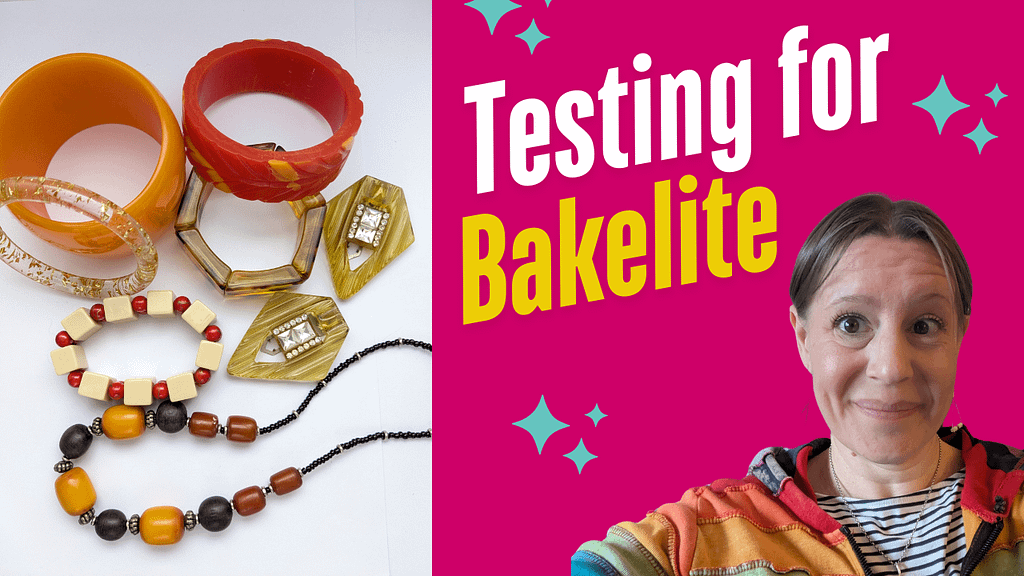
Introduction
Bakelite jewellery is a key element in vintage fashion, known for its bold colours and unique craftsmanship. As a vintage jewellery expert, knowing how to identify Bakelite pieces is essential for any collector or enthusiast. This guide will explore what Bakelite is, how to recognize it, and tips for identifying genuine Bakelite jewellery in today’s market.
What is Bakelite?
Bakelite, a type of early plastic, was developed in 1907 by Belgian chemist Leo Baekeland. It was one of the first synthetic plastics, and its versatility made it a revolutionary material in the early 20th century. Bakelite was used in everything from radios to automotive parts, and it quickly gained popularity in the jewellery world during the Art Deco period.
The material is a type of phenolic resin that is heat-resistant, durable, and can be moulded into various shapes. Its versatility allowed jewellery designers to create bold, colourful pieces in a variety of styles. The distinctive qualities of Bakelite, like its glossy finish and vibrant colours, made it a favourite for accessories, especially in the 1920s and 1930s.
By the 1920s, the material had become a symbol of modernity, and many jewellery designers began experimenting with it. The streamlined, geometric shapes of the Art Deco period complemented the sleek, polished finish of Bakelite. The rise of Art Deco, combined with the advent of Bakelite, created an iconic period for vintage jewellery.
Bangles, necklaces, earrings, rings and dress clips where made from Bakelite. It was used to create all kinds of shapes including fruits, animals and plants, adding a fun element to plastic jewellery.
During the 1940s, Bakelite’s popularity waned with the advent of newer synthetic materials, but it saw a resurgence in the 1980s as vintage fashion became highly sought after.
How to Identify Bakelite Jewellery
If you are lucky enough to find a piece of Bakelite in the wild, being able to validate its authenticity is vital. Identifying genuine Bakelite jewellery can be tricky, especially with so many replicas and similar materials on the market. However, there are several techniques that can help you differentiate Bakelite from other plastics or resins:
1. The Scent Test
Bakelite is made from phenolic resin, which has a distinct smell when exposed to heat or friction. You can gently rub a piece of Bakelite jewellery with your finger, and then quickly smell your finger. If it has a distinct “formaldehyde” or “chemical” scent, it is likely genuine Bakelite. Be cautious with this method and avoid doing it with pieces that might have fragile finishes.
2. The Hot Water Test
Bakelite, when exposed to heat, can react in a unique way. To perform this test, drop a small piece of the jewellery (or use a part of a less valuable piece) in hot water. Once it cools, rub it with your fingers. If the piece emits a faint smell, and you feel a slight waxy residue, it is likely Bakelite. Note that this test can leave residue, so use caution.
3. The Sound Test (The Click Test)
Bakelite is a dense material and has a distinct sound when tapped. Hold the piece near your ear and gently tap it with your fingernail or a hard object. Bakelite will produce a solid, almost “clicking” sound, similar to tapping a piece of wood or a ceramic. This is a reliable test, as it differs from the hollow sound that other plastic materials might produce.
4. Weight
Bakelite is a dense and heavy plastic. It will feel heavier than other plastics. Hold your item in one hand and a different plastic item in the other. Do they feel the same? or is your piece heavier?
5. Examine the Colour and Finish
Bakelite jewellery is known for its rich, vibrant colours, often in shades like green, red, amber, and yellow. These colours often have a deep and dull finish. Over time, Bakelite can develop a patina, which might give older pieces a slightly darker or worn appearance. This patina is another tell-tale sign of Bakelite.
6. Placement of fastenings
Always check any fastenings, for example the pin of the back of a brooch. Brooch pins were embedded into the plastic and never glued in place. Riveting was also used to attach fastenings. This is a method of joining parts together using a metal fastener called a rivet.
7. Testing with Metal Polish
Simichrome polish is a widely used tool in Bakelite identification. To perform this test, apply a small amount of Simichrome polish to a cotton cloth and rub it on the piece. If the cloth picks up a yellow or amber colour, the piece is most likely Bakelite. This test works because Bakelite contains certain resins that react with the polish.
In the UK Simichrome can be quite expensive and sometimes difficult to get hold of. An alternative would be Brasso. The polish reacts with the formaldehyde in Bakelite, revealing its authenticity. Here’s how you can safely perform the test:
What You Need:
- Metal polish (Simichrome or Brasso recommended)
- Soft, white cloth or cotton swab
- Mild soap and water (for cleaning afterward)
Steps to Test:
1. Apply a small dab of metal polish to a soft cloth or cotton swab.
2. Gently rub a discreet area of the jewellery, preferably the back or an inconspicuous edge.
3. Inspect the cloth or swab:
If it’s Bakelite, the polish will pick up a yellowish or brown stain, regardless of the original colour of the piece. If there’s no colour change, it might not be Bakelite.
Important Tips:
- Avoid over-polishing: Excessive rubbing can damage the piece.
- Choose a hidden spot: Always test in an area that won’t affect the appearance of the jewellery.
- Clean afterward: Wash the jewellery with mild soap and water to remove any polish residue.
Safety Note:
Be cautious when handling vintage pieces. If you’re unsure or worried about damaging your jewellery, consider consulting a professional appraiser.
8. Baking Soda
Make a thick paste from a small amount of water and some baking soda. Add the baking soda to a teaspoon of water, mix and keep adding until it forms a thick paste. Using a cotton bud/Q-Tip smear the paste onto a small area of the plastic and rub. If the item is made from Bakelite the cotton bud will turn yellow in colour. This is a positive test for Bakelite.
9. Books
Books about Bakelite jewellery can help you to familiarise yourself with popular Bakelite jewellery designs, shapes, colours and styles. Plastic Jewelry by Schiffer contains lots of colourful images as well as some extremely useful information. The Collectors Corner book ‘Bakelite Jewellery‘ is another useful book with full colour photos and a variety of examples. I would recommend having a couple of books on hand, especially if you have yet to find a piece of Bakelite jewellery. Familiarise yourself as much as possible, to increase your chances of finding a piece out in the wild!
How to Spot Fake Bakelite Jewellery
Due to its popularity and collectible value, Bakelite has unfortunately become the target of imitations. Here are some effective tips to distinguish genuine Bakelite from fakes:
1. The “Hot Water” Test
Place the jewelry under hot tap water for about 20-30 seconds.
Imitations, like modern plastics, won’t produce this smell.
2. Weight and Density
Real Bakelite feels heavier and denser compared to lightweight plastic imitations.
Pick up the piece and get a sense of its weight—Bakelite has a substantial feel.
3. Sound Test
Lightly tap two pieces of Bakelite together. Authentic Bakelite produces a deep, clunky sound, while plastic imitators have a lighter, higher-pitched sound.
4. Colour Characteristics
Real Bakelite colours tend to mellow or darken over time due to oxidation.
Fakes often appear bright and shiny without the aged patina.
5. Seam Marks
Bakelite is typically moulded without visible seam lines.
Fake pieces, especially modern plastics, may have visible seams or injection points.
6. Chemical Test – Metal Polish
As mentioned earlier, applying metal polish like Simichrome or Brasso can reveal a yellowish-brown stain if the piece is authentic.
No reaction indicates it may not be Bakelite.
7. Beware of “Catalin” Confusion
Catalin is another form of phenolic resin, very similar to Bakelite but slightly clearer and prone to discoloration. It’s still collectible but often confused with other fakes.
Caring For Bakelite Jewellery
While Bakelite jewellery is sturdy, it still requires proper care to ensure it can be worn for many years to come. Avoid exposing it to harsh chemicals or extreme temperatures, as this can cause damage. Clean your Bakelite jewellery with a soft cloth to remove dirt and oils, and store it in a cool, dry place away from direct sunlight to prevent discoloration.
Most importantly, wear and enjoy your Bakelite jewellery! Don’t just hide it away in a drawer or cupboard, let it bring you joy.
Conclusion
Identifying genuine Bakelite jewellery can be an exciting and rewarding experience for collectors and vintage enthusiasts. With the right knowledge, you can easily spot Bakelite’s unique qualities and appreciate its role in the history of fashion. Whether you’re looking to add a piece to your collection or simply wish to learn more about vintage jewellery, understanding how to identify Bakelite is an essential skill.
When testing for Bakelite make sure to use more than one test to confirm your results. Having a positive result across a number of tests is much more reliable than a positive result from just one testing method. For example, some pieces will have a stronger smell than others. If you’re piece only has a slight scene to it, performing other tests will help you to confirm or eliminate Bakelite.
Why not watch my YouTube video and bring this information to life! Simply click on the image below:

What ever the results plastic jewellery is a great way to add a splash of colour and fun to your style.
Wear it, enjoy it and love it forever.
